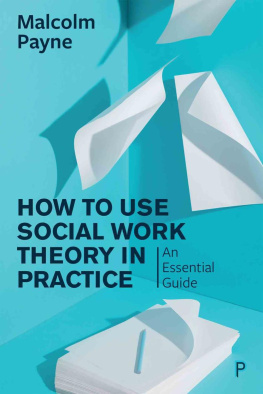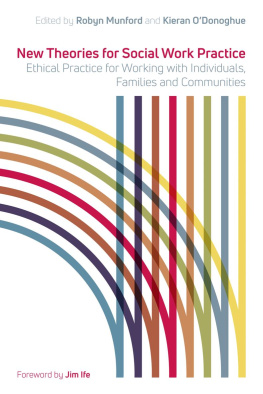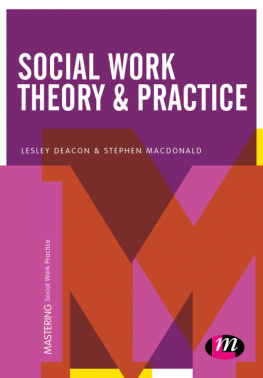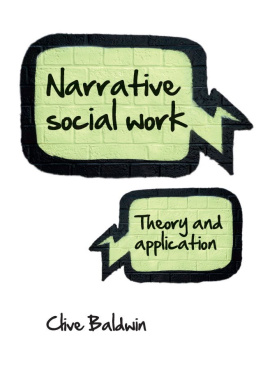
First published in Great Britain in 2020 by
Policy Press University of Bristol 1-9 Old Park Hill Bristol BS2 8BB UK t: +44 (0)117 954 5940 www.policypress.co.uk | North America office: Policy Press c/o The University of Chicago Press 1427 East 60th Street Chicago, IL 60637, USA t: +1 773 702 7700 f: +1 773-702-9756 www.press.uchicago.edu |
Policy Press 2020
British Library Cataloguing in Publication Data
A catalogue record for this book is available from the British Library
Library of Congress Cataloging-in-Publication Data
A catalog record for this book has been requested
978-1-4473-4377-6 paperback
978-1-4473-4378-3 ePub
978-1-4473-4380-6 ePDF
The right of Malcolm Payne to be identified as author of this work has been asserted by him in accordance with the Copyright, Designs and Patents Act 1988.
All rights reserved: no part of this publication may be reproduced, stored in a retrieval system, or transmitted in any form or by any means, electronic, mechanical, photocopying, recording, or otherwise without the prior permission of Policy Press.
The statements and opinions contained within this publication are solely those of the author and not of the University of Bristol or Policy Press. The University of Bristol and Policy Press disclaim responsibility for any injury to persons or property resulting from any material published in this publication.
Policy Press works to counter discrimination on grounds of gender, race, disability, age and sexuality.
Infographics by Carly Powell Design
Cover design by blu inc, Bristol
Front cover image: Stocksy.com
Contents
How people use social work terms varies around the world and I have tried to standardize the terms I use. I explain here my decisions, and hope that readers do not find these uncomfortably distracting.
Carer, caregiver
Carer is the term used in British social care services for people who provide practical care, for example foster carers, neighbours, relatives and people employed to provide home care. The standard term in international use is caregiver. I have preferred carer because it is briefer and British carers often say it is less professionalized than caregiver.
Client, service user
Client is the most widely used term internationally for people who receive social work services. It was originally introduced to avoid terms like the medical patient and to reflect the expectation that, like clients of accountants and lawyers, social work clients were supposed to have a degree of self-direction in how and whether they used social work services. Another usage of the word client, however, describes a subordinate relationship. Some social workers are uncomfortable with that and the fact that, in practice, social work clients often have little power of self-direction. As the service-providing element of social work became important with legislative changes in the 1990s, the term service user has become pre-eminent in the UK, but it is also criticized for treating clients as without agency or control and for reducing social work to using services rather than participating in a shared helping endeavour. I have preferred client because of this, because it is briefer and because of its wide use internationally.
Intellectual disabilities, learning disabilities
Learning disabilities is used in the UK and elsewhere to describe people without fully developed learning and thinking capacities. It is a euphemism displacing older stigmatizing terms still used in some countries, for example retardation, subnormality. Intellectual disabilities, a medical and psychological usage, is preferred in international and research literature as a more accurate description of the multitude of conditions included in this administrative category. I have preferred it for this reason, even though some people find its medical and professionalized character confusing and impersonal.
Social care, social services, social work
In much of the world, a wide range of provision for helping people affected by social disadvantage is described as social work, a term originally introduced to distinguish practical helpers from social reformers and social researchers. The term social services is sometimes used to describe services offering this kind of help but it can be confused with wider social policy and provision. The English government has preferred social care, mainly by analogy with, and to make a political link to, healthcare services. Its use also emphasizes that social work often delivers services and seeks to distinguish current from 20th-century provision.
Since this book is about professional practice derived from theories of the international social work discipline and profession, I have mainly referred to social work. Even though social care is not in wide use outside the UK, I use it as an understandable way to refer to services in which social work participates, as distinct from the professional practice.
The aim of this book is to offer brief accounts of how to practise according to the social work professional literature about specific practice concepts and practice theories. The account of each concept or theory covered focuses on the practice requirements set out in the literature rather than the professional discourse about the concept or theory; I explain the reasons for this in the Introduction. Chapters take up each concept and theory separately, rather than exploring its intersections with other theories and ideas. Each chapter also takes the literature about that concept or theory at face value, not debating conceptual or ideological issues that arise with using that concept or theory.
The concepts or theories vary in what they offer the social work practitioner. Some are presented as a sequence of steps, while others offer more of an approach or set of values about how to practise according to their premises. So, although the chapters are in a standardized format, I have been led by the approach and emphasis of the relevant literature in presenting them.
Each chapter has two different forms of presentation:
The chapters text explains the nature of the concept or theory, its aims, how it is or might be used, the practice interventions that emerge from the literature, and some things that you should think about as you practise. You would use this to gain an overview of what the concept or theory says you should do when you practise according to its precepts.
The chapters infographic presents a summarized account of the concept or theory as a diagram, in a page or less. You would use this as a reminder of the main directions and elements of practice. I have standardized the format of the infographics, and, while I hope they are reasonably intuitive, please look at ).
Some people find purely textual or graphical presentations difficult and like to use them together to supplement their understanding, others find one or the other difficult to follow. I hope it is helpful to offer both.
These presentations of the practice elements of social work, practice concepts and theory may be helpful in various ways:
If you are a student or are otherwise in the early stages of using social work ideas and literature, they enable you to highlight the practice implications rather than other aspects of your studies. As many students have said to me: What does this theory mean for practice if we strip away the debate and the jargon?












